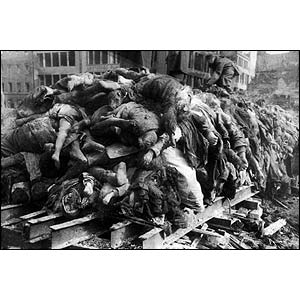
These are thoughts of another war, and the state terrorism practiced by all combatants.
Germans are finally coming out of their bunkers only decades after the firestorms of World War II.
Jörg Friedrich is the author of a new book, Brandstätten (Fire Sites), composed largely of photographs depicting grisly evidence of the civilian casualties which resulted from the allied bombing of Germany's cities during the second world war. Friedrich himself has now become part of a storm of words, nowhere more than in Germany itself. From The Guardian account:
"The bombing left an entire generation traumatised. But it was never discussed. There are Germans whose first recollections are of being hidden by their mothers. They remember cellars and burning human remains," Friedrich told the Guardian in an interview in Berlin last week.The author maintains that the allied bombings, which incidently almost totally destroyed the fabric of 160 medieval cities, was a war crime, in particular the bombs dropped on the militarily insignificant civilian centers of a shattered Germany in the last few months of the war."It is only now that they are coming to terms with what happened."
Around 600,000 German civilians died during the allies' wartime raids on Germany, including 76,000 German children, Friedrich says. In July 1943, during a single night in Hamburg, 45,000 people perished in a vast firestorm.
But in the immediate post-war period, the German victims of British bombing were scarcely mentioned, being overshadowed by the far greater evil of the Holocaust.
Friedrich believes that most Germans refused to discuss what had happened because they regarded the British destruction of their cities as a sort of retribution for the crimes of the Nazi era.
Reaction to Brandstätten has been critical. A reviewer for the Süddeutsche Zeitung, even suggested that it should be thrown in the bin, and a cultural magazine program on German public television dismissed it as a "provocation" that sought to "compare the air war with the Holocaust", a reference which is as much an obstacle for free thought in Germany as it is in the Middle East and elsewhere.
The author had originally planned to produce a book which would include images of the horrors visited by Nazi Germany upon civilians in Poland, The Netherlands Britain and elsewhere. For the images he ultimately used in the book Friedrich combed the dusty archives of cities and towns all over Germany, but the larger scale of the project was blocked by the British. The BBC site reports:
. . . he says the British Public Records Office would not release the kind of horrific images that he found of German victims.Over the Channel too. Odd that Britain still will not permit the release of images of its civilian dead 60 years after the horrors they suffered. A prohibition which might originally have been represented as part of a nation's campaign to maintain a beleagured people's war-time morale just doesn't seem to be defensible today."There were 15,000 deaths in southern British cities between September and December 1940. But you won't see any photos of them," he says.
"The Germans admired the endurance of the Londoners in the Tube stations. But this is the heroic story. If you look at the image of the suffocated grandmother cradling her grandchild in a [German] bunker, there is no heroism."
Keeping pictures like that, and the ones in the book, under wraps may be regarded as a sign of sensitivity - maintaining the dignity of the victims. But could it also produce a censored, sanitised version of history?
"Goebbels forbade these photos of our victims from the German papers," says Mr Friedrich. "In a way, we've obeyed his orders until this day."
Not much has changed. We see no images of Iraqi war dead today, and may never see them. In fact, we don't even see images of our own dead - or even images of the injured. War is kept very clean for those who aren't there.
The Leo Baeck Institute and the Goethe Institute will be presenting a panel discussion on this subject here in New York next Wednesday, October 29, titled "German Civilians as Victims? The Evolution of a Perception".
Participants will include Dr. Frank Bojahr, The Institute for Contemporary History, University of Hamburg; Atina Grossmann, professor of history, Cooper Union; Dr. Volker Hage, journalist for Der Spiegel (Hamburg); and Andreas Huyssen, Villard Professor of German and Comparative Literature, Columbia University. The moderator will be Dr. Frank Mecklenberg, the director of research and chief archivist at the Leo Baeck Institute.
Their announcement includes the following information: The panel discussion is to be preceded by a screening of "The War of the Century-Firestorm" (Der Jahrhundertkrieg-Feuersturm). 2002. Produced by Guido Knopp. Written and directed by Peter Hartl and Annette Tewes. [52 min. In English and German with English subtitles. Courtesy ZDF] The film features historical footage from WWII as well as interviews with German civilians who experienced the massive bombing of such cities as Hamburg, Dresden, Cologne, and Berlin, and with American and British bomber pilots recalling the bombardments.
The film will begin at 6, and the discussion at 7. The location is the Goethe Institute, at 1014 Fifth Avenue, between 82nd and 83rd Streets.
For reservations and information we are asked to call (212) 439-8700.
I'm definitely going to be there. If you plan to go also, please let me know.
[the story and the texts quoted are from The Guardian and BBC News, where images from the book can be found, including that above, of Dresden in 1945]
kind of puts 9/11 into its perspective